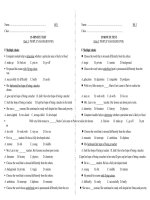Reading 15
Bạn đang xem bản rút gọn của tài liệu. Xem và tải ngay bản đầy đủ của tài liệu tại đây (56.29 KB, 3 trang )
READING 15
The smooth operation of an ant colony depends on ten to twenty different signals,
most of which are pheromones (chemical signals triggering behavioral responses).
It is estimated that red fire ants employ at least twelve different chemical signals.
The simplest of these is the carbon dioxide from the respiration of an ant cluster, a
chemical that acts as a pheromone to promote aggregation. Workers move toward a
source of carbon dioxide, resulting in solitary ants moving to join a group. At the
other extreme, the most complex of the fire ants' signals is probably colony odor,
by which the workers of a particular colony or nest identify another worker as local
or foreign. Each ant nest has its own odor as a result of its location, history, and
local food supply. The resident ants pick up this odor on their bodies, so that ants
of the same species, but from different nests, have different colony odors. This
allows ants to identify intruders and maintain colony integrity.
Fire ants also make use of an alarm pheromone to alert workers to an emergency,
and their scouts lay down a trail pheromone as a guide during mass migrations. A
fire ant queen emits a chemical signal that identifies her to the colony's workers.
They respond by scurrying to gather around her. The decomposing corpse of a
dead ant also generates a signal, to which workers respond by eliminating the
corpse from the nest.
Ants provide examples of both public (accessible to other species) and private
messages. One of their most important private messages concerns food, for a food
source is worth keeping secret. Each species marks its trails with signals that are
meaningless to others, so that an ant crossing a trail left by another ant species
typically notices nothing. On the other hand, a secret signal to mark a dead body is
unnecessary. Many kinds of ants perceive a natural decomposition product of dead
insects as a signal to remove a corpse. If an outsider recognizes this message and
moves the body, no harm is done.
21. What aspect of ants does the passage mainly discuss?
(A) The relationship between the queen and the worker ants
(B) Ways in which ants use chemical signals
(C) Methods ants use to identify food sources
(D) The importance of respiration in the production of ant pheromones
22. The phrase "smooth operation" is closest in meaning to
(A) daily activity
(B) effective functioning
(C) delicate balance
(D) permanent location
23. According to the passage, carbon dioxide serves which of the following
functions for fire ants?
(A) It protects the queen.
(B) It attracts other ant species.
(C) It informs workers of possible danger.
(D) It encourages the ants to gather together.
24. The word "cluster" is closest in meaning to
(A) organ
(B) activity
(C) group
(D) cycle
25. According to the passage, each nest has a distinct odor that allows its
inhabitants to
(A) find the location of the nest in the dark
(B) distinguish worker ants from other ants
(C) distinguish foreign ants from resident ants
(D) signal other inhabitants when foreign ants attack
26. The word "alert" is closest in meaning to
(A) allow
(B) transport
(C) ware
(D) provide
27. What is the role of pheromones in the mass migrations of ants?
(A) Pheromones are used to create a trail that directs the ants during migrations.
(B) Pheromones signal the ants that the nest has been invaded and must be
abandoned.
(C) Pheromones control the speed at which ants move from one location to
another.
(D) Pheromones enable scouts to identify suitable areas for establishing a new nest.
28. The word "scurrying" is closest in meaning to
(A) agreeing
(B) appearing
(C) competing
(D) rushing
29. The word "others" refers to
(A) private messages
(B) species
(C) trails
(D) signals
30. Why does the author mention "dead insects"?
(A) To compare the social behaviors of ants with those of other insects
(B) To emphasize the dangers that all insects encounter
(C) To argue the superiority of ants over other insects
(D) To indicate a behavior that is common among various kinds of ants
31. Which of the following terms is defined in the passage?
(A) pheromones (line 2)
(C) mass migrations (line 14)
(B) colony integrity (lines 11-12)
(D) private messages (lines 18-19)









